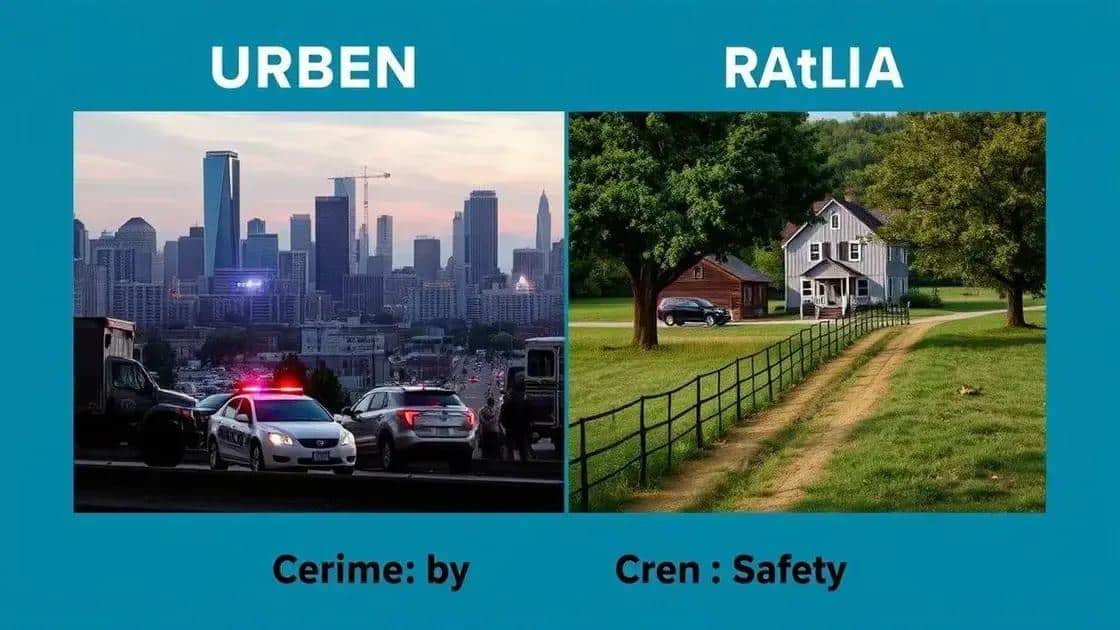Realize crime trends usa: Understanding the dynamics

Understanding and addressing crime trends in the USA involves analyzing data, engaging communities, and implementing targeted prevention programs to enhance safety and reduce crime rates effectively.
Realize crime trends usa provides insights into the evolving landscape of crime across the country. Have you ever wondered what influences these trends and how they affect your community? In this article, we’ll delve into the factors shaping crime patterns and their broader implications.
What are the current crime trends in the USA?
Understanding current crime trends in the USA is crucial for communities and law enforcement agencies. It reveals the patterns of criminal activity and helps address the root causes effectively. Crime rates can fluctuate yearly due to various factors.
Types of Crime Being Reported
Different types of crime dominate headlines and police reports. Notably, violent crimes and property crimes are the most significant categories. Each category contains various offenses, which can change over time based on social dynamics.
- Violent crime, including murder and assault
- Property crime, such as burglary and theft
- Cybercrime, growing in the digital age
- Drug-related offenses, often linked to underlying issues
Some areas see a rise in specific types of crime, while others experience a decline. Factors such as economic conditions, community programs, and law enforcement practices can contribute to these changes. For instance, urban areas may report higher rates of violent crime compared to rural areas.
Regional Patterns
It’s also essential to note how crime trends can significantly differ by region. Some states experience spikes in certain offenses, prompting discussions on public safety and law enforcement resource allocation.
Additionally, national events or crises can affect these trends. For example, during economic downturns, property crimes often see an increase as individuals face financial hardships. Understanding these patterns helps local governments and agencies prepare and respond appropriately.
In summary, staying informed about the current crime trends in the USA provides valuable insights. The ability to recognize shifts in crime patterns allows communities to adapt and implement strategies to enhance safety.
Factors influencing crime trends today
Several factors influencing crime trends today can create significant changes in how crime is reported and addressed. Understanding these elements helps communities and law enforcement strategize effectively.
Economic Conditions
One main factor is the economy. During tough economic times, such as recessions, crime rates often increase. Individuals facing financial hardships may resort to crime out of necessity or desperation. This can lead to higher rates of theft and property crimes.
- Unemployment rates directly impact crime.
- Poverty can lead to increased desperation.
- The availability of resources can reduce crime.
- Crisis events, such as pandemics, can disrupt community services.
Moreover, the availability of social services plays a crucial role. Areas with strong support systems, such as job training and educational programs, tend to face lower crime rates. Communities that address underlying issues often see positive results.
Community Engagement
Community involvement also shapes crime trends. When residents actively participate in neighborhood watches or local events, it helps deter criminal activity. Strong community ties create safer environments and promote trust among residents and law enforcement.
Another vital element is the influence of technology. With the rise of smartphones and social media, information travels quickly. **Crime reporting apps** and social media platforms allow individuals to report suspicious activity immediately, leading to quicker law enforcement responses.
Policies and legislation impact crime trends too. Changes in law enforcement practices, sentencing laws, and drug policies can create shifting crime patterns. For example, the decriminalization of certain substances has led to decreases in arrests related to drug offenses.
Finally, the overall public perception and media portrayal of crime contribute to how trends are viewed. With sensationalized news coverage, public fear can sometimes overshadow actual crime rates, influencing policy and community action.
How crime trends vary by region

The way crime trends vary by region is crucial to understanding the unique challenges that different areas face. Factors such as population density, economic conditions, and community engagement can influence crime rates significantly.
Urban vs. Rural Areas
Urban areas often report higher crime rates compared to rural regions. The density of people can lead to increased opportunities for both violent and property crimes. Cities may struggle with gang activity and drug-related offenses due to their larger populations and anonymity.
- Higher rates of violent crime in cities.
- Increased property crime in densely populated areas.
- Rural areas often deal with fewer crimes, but may face unique issues such as drug abuse.
Conversely, rural areas can experience different challenges, including a lack of resources. Law enforcement may respond more slowly due to distance, leading to different crime dynamics.
Regional Characteristics
Crime trends can also vary widely by state and region. For example, coastal areas might see different issues compared to those in the Midwest. Issues such as tourism can spike certain crimes, like theft and burglary, in popular destinations.
Additionally, some states may be more affected by specific crimes based on local laws or demographics. For instance, states with strict gun control laws may have different homicide rates compared to those with more lenient laws. Moreover, cultural factors and community attitudes towards law enforcement can impact crime reporting and prevention efforts.
Understanding these nuances is essential for lawmakers and community leaders to develop effective strategies. By recognizing what drives crime in various locations, they can tailor approaches to address specific issues and enhance public safety.
Impact of crime trends on communities
The impact of crime trends on communities is profound and multifaceted. Changes in crime rates can alter the fabric of a community, shaping how residents feel about safety, local investment, and overall quality of life.
Emotional and Social Effects
One significant impact is the emotional toll that crime can take on residents. High crime rates often lead to fear and anxiety among community members. People may feel unsafe in their neighborhoods, which can affect their willingness to engage in community activities.
- Increased anxiety about personal safety.
- Reduced trust among community members.
- Withdrawal from community activities.
- Impact on mental health, leading to stress and depression.
Furthermore, crime trends can create a loss of community cohesion. When residents perceive their neighborhood as unsafe, they may avoid connecting with their neighbors or participating in local events. This disconnection can hinder efforts to build strong support systems within the community.
Economic Consequences
Moreover, crime can have economic repercussions. Areas with high crime rates often see reduced property values, which can lead to a decline in investment. Business owners may think twice about opening or expanding in areas known for crime, limiting job opportunities for residents.
Property owners may face higher insurance costs and increased maintenance needs, further straining their finances. Additionally, local governments might see a rise in policing expenses, diverting funds from vital services like education and public health.
A high crime rate can also deter tourism and local events. Fewer visitors can lead to lost revenue for businesses, creating a cycle of economic decline. As businesses close or relocate, the community can experience increased unemployment and decreased resources.
Communities affected by crime must confront these challenges to foster safer environments. Engaging residents in prevention initiatives and promoting community programs can help break the cycle of crime and its adverse effects.
Addressing and preventing crime based on trends
Addressing and preventing crime based on trends is essential for creating safer communities. Using data-driven approaches helps pinpoint areas needing attention and resources. Effective prevention strategies rely on understanding local crime trends.
Data Analysis and Community Engagement
One of the first steps is analyzing crime data to identify patterns. Law enforcement agencies utilize crime reports to understand when and where crimes occur. This analysis helps them focus efforts on high-risk areas at critical times.
- Understanding local hotspots enhances police patrols.
- Timely data allows for targeted community programs.
- Events like community forums can help gather local insight.
- Involving residents fosters collaboration between law enforcement and communities.
Communities can also participate actively in crime prevention. When residents understand trends, they can adopt measures to enhance safety. For example, neighborhood watches empower communities to monitor activities and report suspicious behavior.
Implementing Prevention Programs
Prevention programs tailored to specific crime trends can be particularly effective. Programs might include youth engagement activities to deter juvenile delinquency or workshops on conflict resolution. By targeting specific groups or issues, these initiatives can tackle the root causes of crime.
Schools and local organizations also play a role in crime prevention. Educating youth about the consequences of crime can steer them away from criminal behavior. Additionally, providing recreational activities keeps young people engaged and fosters a sense of community.
Technology can aid in crime prevention as well. Crime mapping tools, for instance, help law enforcement visualize crime trends and allocate resources more effectively. Furthermore, community members can use apps to report crimes or suspicious activities, facilitating quicker police responses.
By continuously monitoring trends and adapting strategies, communities can work collaboratively to reduce crime and improve quality of life.
FAQ – Frequently Asked Questions about Crime Trends and Community Safety
How can understanding crime trends help my community?
Understanding crime trends helps identify problem areas and allows communities to implement targeted strategies for prevention and safety.
What role does community engagement play in crime prevention?
Community engagement fosters trust between residents and law enforcement, encouraging collaboration in safety efforts and reducing crime rates.
What are some effective crime prevention programs?
Effective crime prevention programs include neighborhood watches, youth engagement activities, and educational workshops on safety and conflict resolution.
How can technology assist in addressing crime trends?
Technology, such as crime mapping tools and community reporting apps, allows for quick responses to suspicious activities and helps allocate resources effectively.





